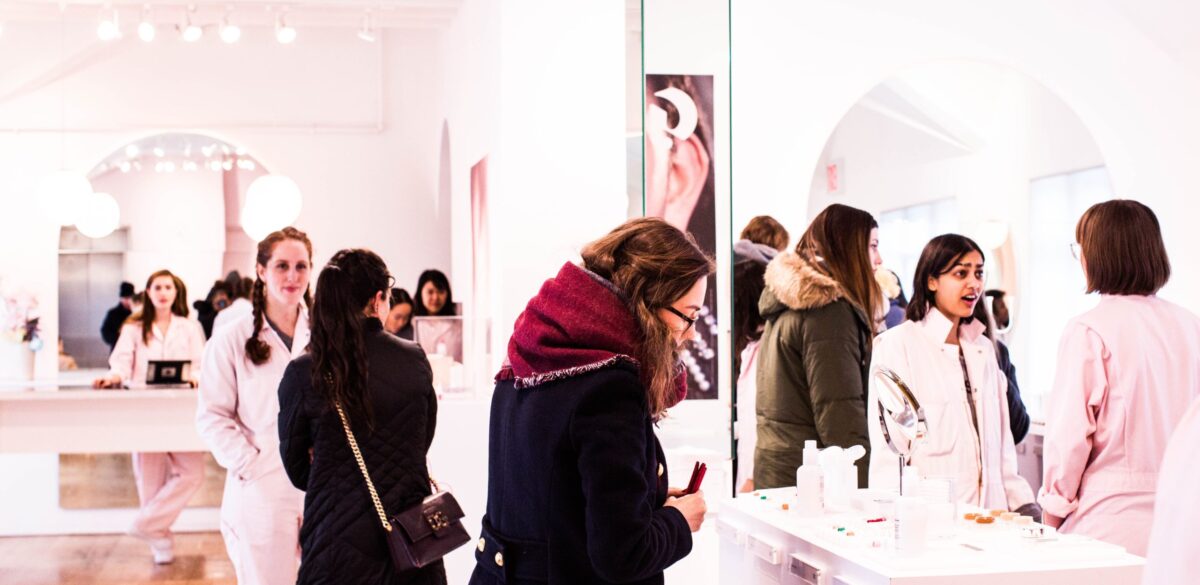Pop-up retail events – commonly known as flash retailing – are an emerging marketing tool used by brands to boost their sales. At these pop-up events, a brand will set up their products and services at a temporary location, and through event marketing, will hype these events as the ultimate place to be at. These temporary spaces have the potential to become a major brand-boosting tool for weeks when planned and executed properly.
In 2019, the pop-up event market is exceeding expectations for growth and projected to bring in $10 billion. Why are pop-up shops so successful? With more customers looking for experiences (especially millennials and Gen Z), pop-up events offer the opportunity to access exclusive events and products because of the fear of missing out (aka FOMO). For brands, the low overhead allows for greater profits.
Consumers love pop-up shops. Specialization, exclusivity, and the opportunity to try products usually only available online contribute to their appeal. In one survey, 61% of consumers stated that seasonal shopping was their primary reason for going to pop-up shops. From farmers’ markets to Christmas markets, pop-up shopping is the best way to get in-season products otherwise unavailable for the rest of the year.
30% of shoppers attributed their shopping at pop-ups to the fun of the experience. The appeal of flash retail grants a sense of adventure to your shopping trip, aligning with changing trends in how consumers spend their money – looking more for experiences than products.
With a well-planned pop-up event, your brand can benefit greatly. If you haven’t planned a pop-up event before, here are 7 tips for planning a successful event.
1. Pick the Right Location
Although just about any public place can be converted into a venue, when planning the location having an element of surprise is important. Select locations that distinguish your brand from other pop-up events. Since pop-up events can be face to face with target audiences directly engaging or virtual with video calling, or even a hybrid of them both, it’s important to hold these events at locations that have basic amenities. They can be held in hotels, resorts, parking lots, unused retail offices, shopping malls or even in empty buildings.
2. Have a Balanced Budget
Set a fixed budget at the start of the project. Make sure you address these issues before setting a budget:
- How many people are expected to attend the event?
- What equipment do you need to rent?
- What will you be serving?
- How are you going to ship all the products to the location?
If you have a steady theme and concept in mind, even a small budget targeting topics and themes that the crowd may love is possible with smart planning.
3. Invest in Event Management Technology
Technology like digital kiosks, VR Stations, giant touch screens, and event planning software can have a massive impact at pop-up events. Investing in event management technology when planning one of these events is a must. You must invest in:
- Technology to create the Right Atmosphere: The right atmosphere at a pop-up event is what makes it attractive enough for people to stop by and check out the brand. Since technology has made inventions like 3D projection mapping extremely inexpensive and accessible, it is very easy to make guests feel welcomed at these events.
- Create Customer Engagement with Pictures and Videos: Montages, 3D screens, interactive screens, and photo booths are all effective methods of capturing the attention of consumers. “Do it for the Gram” is a popular term at pop-up events because consumers want to take photos to show they were at the event.
- Free Wi-Fi Connectivity and Bandwidth: Make sure there’s enough bandwidth to back all exhibitors. Provide a free hotspot to attract crowds. Wi-Fi, presentation tools, AV setups are all musts at most effective pop-up events.
- Technology for Guest Comfort: It is normal for companies to invest in air-conditioning and heating systems. All of these little details play a major role in creating the right impact on the target audience.
The best way to simplify your event management process is to invest in technology that helps with event management and automation. Attendease, for example, is the leading provider of event management technology for pop-up events, helping to plan events of all sizes. Attendease’s modern approach to efficiently manage these events has raised the bar for pop-up event planning. We help in consolidating all your efforts on one platform, managing the overall event portfolios of major brands. They provide –
- Automated Event Lifecycles: Attendease’s repeatable and measurable event arrangement procedure focuses on cloning top-quality event settings at different locations, investing heavily in websites, creating strict workflows, managing participant lists, etc.
- Create the best attendee experience: Providing a fully-branded and approachable experience to your participants is important. Be it by providing them with well-built event websites, offering customizable registration procedures, or strong email marketing – paying attention to your attendees is crucial. Our effective member profile supervision, program scheduling, messaging patterns, etc. make them the ideal partners for such ventures.
4. Promote the Event on Social Media
The key to getting success at a pop-up event is to garner enough excitement in the masses so that a certain number of fixed participants are guaranteed to visit, irrespective of the time frame. Social media is the best tool for driving curiosity and excitement in the public. Creating an event on Facebook, hosting an Instagram Live and working with influencers during these events are the best ways to attract the masses.
Make sure to use a hashtag for these events to further brand the event.
5. Provide Food and Beverage Service
For successful pop-up events, providing a clean and hygienic food and beverage experience is a must. Only serve fresh food and drinks at optimal temperatures. No one likes warm soda and overly hot sandwiches. A lot of companies have developed new, low-maintenance technology to keep food and drinks fresh at remote locations. Strike a partnership with some of these companies before launching an event.
6. Offer Cashless Payment Options
Cashless payment technology supervises payments rapidly and guarantees accuracy. With mobile payment options, customers can pay directly instead of having to wait in long lines to make their purchase. There is an extensive range of mobile payment options including PayPal, Square Cash and more who can help provide the technology needed for these events.
7. Connect with Professional Photographers and Videographers
Because of the social aspect and large crowds at these events, make sure to have a professional team of photographers and videographers available. They can capture the key moments of the event and help you prepare content to share it online. Whether it’s images for Instagram, videos for YouTube
Conclusion
Since there’s so much room for improvisation when designing a pop-up event, there are countless ways of making the crowd interested and excited about the event. These seven factors are absolute musts when planning for a pop-up event.
When managing pop-up events, a powerful and easy to use event management and automation platform will help to make planning, marketing and reporting even easier.
Attendease is a powerful event management software and automation platform designed specifically for corporate event teams. By helping you address the entire event lifecycle, using Attendease can reduce event costs and make events easier to run. Find out how Attendease can help by requesting a demo.

